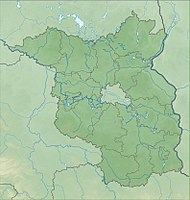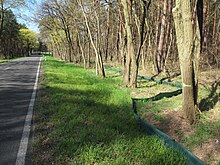Reichardtsluch
|
Reichardtsluch /
FFH area: Schwenower Forest addition IUCN category Not reported - |
||
|
The larger of the two shallow lakes in the Reichardtsluch, April 2015 |
||
| location | Limsdorf , district of Storkow , Dahme-Heideseen Nature Park , Brandenburg , Germany | |
| surface | 2 ha | |
| WDPA ID | 555519209 | |
| Natura 2000 ID | DE-3850-303 | |
| FFH area | 29 hectares | |
| Geographical location | 52 ° 10 ' N , 14 ° 2' E | |
|
|
||
| Setup date | 2003 | |
| particularities | Lynx with representative regional concentrations of crested newt ( Triturus cristatus ) and fire-bellied toad ( Bombina bombina ) | |
The Reichardtsluch (other spellings: Reichardsluch, Reichards-Luch ) is a luch in the Limsdorf district of the city of Storkow in the Oder-Spree district of Brandenburg . It is located in the Dahme-Heideseen nature park .
The roughly two hectare wetland consists of two small shallow bodies of water with strong seasonal water level dynamics . Due to its representative regional focus on the "strictly protected" species crested newt ( Triturus cristatus ) and red-bellied toad ( Bombina bombina ), the lynx was included in the Natura 2000 network as an addition to the FFH area Schwenower Forest . The FFH area Schwenower Forest addition includes the surrounding, woody, loamy-sandy land habitats and winter quarters of the amphibians on 29 hectares . The sanctuary and the main animal spawning route are crossed by a state road on which an amphibian protection fence has been erected.
Location and natural space
The Reichardtsluch is located in the south-western part of the Beeskower Platte , which is listed as No. 824 in the main natural units of Germany in the main unit group No. 82 East Brandenburg Heath and Lake District . The flat, undulating plateau is predominantly a floor moraine from the Saale Ice Age , the surface shape of which was formed by renewed glaciation in the last Ice Age .
The Luch is located on the eastern district of Limsdorf on the border with Ahrens village , in the municipality of Rietz-Neuendorf , just south of the main road 42 , which connects the two cities. The much larger FFH area extends north over the street. The center of the city of Storkow is around 12.5 kilometers northwest, the core of the city of Beeskow around 14 kilometers east. The distance to the south-eastern Berlin city limits is around 42 kilometers (all data refer to the air line ).
Reichardtsluch
“The two hectare wetland is constantly changing in appearance. Sometimes it is filled with water, sometimes it dries out completely. The maximum water depth in wet years is a little less than a meter. ”It consists of two lakes that are connected when the water level is sufficient. The larger, northern lake stretches around 300 meters from north to southwest, its maximum width is around 55 meters. The smaller lake stretches for around 80 meters from north to southeast. Its width reaches a maximum of around 25 meters. The Luch is located in the postglacial channel of the 7.92 kilometer long Schwenowseegraben , a river that is now mostly dry and runs through the Luch from north to south. The Schwenowseegraben rises north of the Luchs near Behrensdorf and ends after flowing through the Schwenowsee in Drobschsee , which drains over the Blabbergraben into the Krumme Spree . The trench crosses the state road in a pipeline . The Schwenowseegraben is part of the Krumme Spree water development concept (GEK) for the near-natural development of flowing waters within the framework of the Water Framework Directive (WFD), which aims to improve the ecological status of various bodies of water and restore their continuity. The white flowers of the water crowfoot ( Ranunculus aquatilis L.) shine on the water in spring , and reeds rise up in the autumn .
The two lakes are shown in maps , but remain unnamed - also in the Brandenburg viewer of the state survey and geographic base information Brandenburg . If you click on the Google Maps in the lakes and on the question What is here? , the indication Schwenowseegraben appears . The name Reichardtsluch (or Reichardsluch, Reichard-Luch ) is in publications of the NABU -Regionalverbands Dahmeland and the management of natural parks used Dahme-Heide lakes.
FFH area Schwenower Forest addition
The area's rich amphibian populations came into focus in March 2001 when some crested newts were found on the state road. In the following years, the nature watch recorded the populations of amphibians and reptiles . It turned out that the Reichardtsluch is by far the most important reproduction area of red-bellied toad and crested newt in the Dahme-Heideseen nature park. According to Annex II of the Habitats Directive, both species are among the “species to be strictly protected”, for which “specially protected areas are to be designated”. The area was therefore registered as a supplement to the FFH area Schwenower Forest (area no. 3850-301) to the European Commission and based on the standard data sheets submitted under the area no. 3850-303 Schwenower Forest declared an addition to the FFH area. The FFH profile of the Federal Agency for Nature Conservation (BfN) states in the description: “Representative regional focus on crested newt and red-bellied toad”.
The 29.17 hectare supplementary area includes the surrounding woody heights beyond the core area of Reichardtsluch, also north of the road, which are used by the animals as winter quarters, among other things. The FFH supplementary area is isolated and has no connection to the 745.68 hectare main FFH area Schwenower Forest, which lies to the south and is designated as a nature reserve under the same name . In the mixed forest on the heights above the Reichardtsluch dominate pines .
Amphibians and reptiles
On the 110-meter-long protective fence of the state road, which the animals cross on the main spawning migration from north to south, the animals fall into small buried buckets, are counted and carried across the street by helpers every day in spring. In the spring of 2006 and 2009, the following stocks were recorded in intact spawning waters, and the protection classifications according to the Federal Nature Conservation Act (BNatSchG) and, as of 2004, according to the Brandenburg Red List (RL-BB):
- Fire-bellied toad ( Bombina bombina ): 2006: 705; 2009: 1010; BNatSchG: "strictly protected"; RL-BB: "highly endangered" (level 2)
- Great crested newt ( Triturus cristatus ): 2006: 698 ;; 2009: 247; BNatSchG: "strictly protected"; RL-BB: "at risk" (level 3)
- Pond newt ( Lissotriton vulgaris; Syn .: Triturus vulgaris; see: Triturus ): 2006: 139; 2009: 44; BNatSchG: "particularly protected"; RL-BB: "definitely not at risk" (level **)
- Common toad ( Pelobates fuscus ): 2006: 97; 2009: 103; BNatSchG: "strictly protected"; RL-BB: "safe" (level *)
- Common toad ( Bufo bufo complex): 2006: 8; 2009: 4; BNatSchG: "particularly protected"; RL-BB: "safe" (level *)
- Moor frog ( Rana arvalis ): 2006: 3; 2009: 25; BNatSchG: "strictly protected"; RL-BB: "safe" (level *)
- Common frog ( Rana temporaria ): 2006: 15; 2009: 5; BNatSchG: "particularly protected"; RL-BB: "at risk" (level 3)
- Green frog spec. : 2006: 16; 2009: 24; BNatSchG: some species "strictly protected"; RL-BB: some species “endangered” (level 3).
In addition, three forest lizards ( Zootoca vivipara ; previously Lacerta vivipara ) and one specimen each of the sand lizard (Lacerta agilis) and the slow worm ( Anguis fragilis ), which are “endangered” in Brandenburg, were counted in individual years . Catches on a 25-meter-long test fence erected for comparison on the south-east bank of the spawning water make it clear that the figures mentioned represent only a small part (probably around 10 to 20%) of the actual total populations. For the frog species in particular, much more extensive population figures were extrapolated, also using the results from previous years: for moor frogs 280, common frogs 540 and green frogs spec. 450 copies.
literature
- Frank Schröder: What creeps and flies in the Reichards-Luch? In: Jahre Buch 2008 . Ed .: NABU RV Dahmeland e. V. and Nature Park Dahme-Heideseen (State Office for Environment, Health and Consumer Protection Brandenburg), Prieros, pp. 109–111 PDF .
- Hans Sonnenberg: About padders and adders. What do we know about the amphibians and reptiles in Dahmeland? In: Jahre Buch 2014 . Ed .: NABU RV Dahmeland e. V. and Dahme-Heideseen Nature Park (State Office for Environment, Health and Consumer Protection Brandenburg), Prieros, pp. 116–126 PDF .
Web links
Individual evidence
- ↑ Olaf Juschus: The young moraine south of Berlin - investigations into the young Quaternary landscape development between Unterspreewald and Nuthe. S. 2. Dissertation, Humboldt University Berlin, 2001. Also in: Berliner Geographische Arbeit 95. ISBN 3-9806807-2-X , Berlin 2003. See Figure 2 Plates and glacial valleys in the young moraine south of Berlin in Chapter 1 and Chapter 4 Fig. 32 and subsections 4.3.4.3 and 4.3.4.5 .
- ↑ a b c Land surveying and geographic base information Brandenburg : Brandenburg viewer, digital topographic maps 1: 10,000 (Menu - "More data" - click on and select accordingly; switch to the district boundaries "Real estate cadastre" and there "districts".)
- ↑ Federal Agency for Nature Conservation (BfN): Map service for protected areas in Germany. Dive section (scroll back and forth for the respective protected areas and select the settings in the level overview depending on the type of protected area you are looking for).
- ↑ a b c Frank Schröder: What creeps and flies in the Reichards-Luch? [...] p. 109.
- ^ Landesumweltamt Brandenburg (LUGV): River directory, source data set gewnet25 Version 4.0 . As of April 25, 2014, p. 42.
- ↑ State Environment Agency Brandenburg: EU Water Framework Directive (WFD). Water development concept (GEK) Krumme Spree. ( Memento of the original from August 8, 2014 in the Internet Archive ) Info: The archive link was inserted automatically and has not yet been checked. Please check the original and archive link according to the instructions and then remove this notice. Flyer, Potsdam 2010.
- ↑ Management planning Natura 2000 in the state of Brandenburg. Pp. 37-41.
- ↑ Holger Ellmann, Ingenieurbüro Ellmann / Schulze GbR: Discussion of the principles for establishing ecological continuity in small rivers using the example of GEK "Krumme Spree". ( Memento of the original from April 2, 2015 in the Internet Archive ) Info: The archive link was inserted automatically and has not yet been checked. Please check the original and archive link according to the instructions and then remove this notice. Published by: Ministry for Rural Development, Environment and Agriculture Brandenburg (MLUL), undated.
- ↑ Hans Sonnenberg: From paddles and snakes. What do we know about the amphibians and reptiles in Dahmeland? [...] p. 120.
- ↑ 3850-303 Schwenower Forest supplement. (FFH area) Profiles of the Natura 2000 areas. Published by the Federal Agency for Nature Conservation . Retrieved November 22, 2017.
- ↑ 3850-301 Schwenower Forest. (FFH area) Profiles of the Natura 2000 areas. Published by the Federal Agency for Nature Conservation . Retrieved November 22, 2017.
- ↑ Brandenburg rules System (BRAVORS): Minister of Agriculture, Environmental Protection and Raumordnung.Verordnung over the nature reserve "Schwenower forestry". Potsdam, September 8, 2004. Entry into force of the regulation on October 9, 2004
- ↑ Fence saves the life of amphibians. In: Märkische Oderzeitung (MOZ-online), April 9, 2009.
- ↑ Frank Schröder: What creeps and flies in the Reichards-Luch? [...] pp. 109–111.
- ↑ Natural history annual report 2009 for the Dahme-Heideseen Nature Park. Ed .: Hans Sonnenberg, Ed .: Nature Park Administration and Nature Watch of the Dahme-Heideseen Nature Park. Prieros, 2010. See Chapter 5.3.1., Table: Recordings of migrating amphibians on the Reichardtsluch , p. 24.
- ↑ NABU : Amphibian and Reptile Protection Current. Red lists. (Without date; accessed April 27, 2015.)



